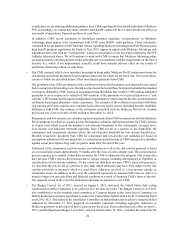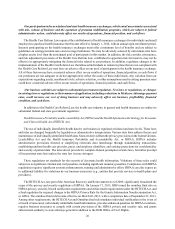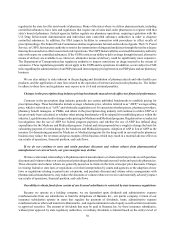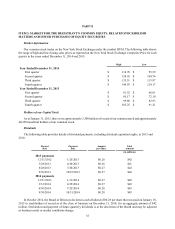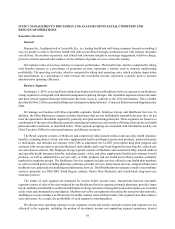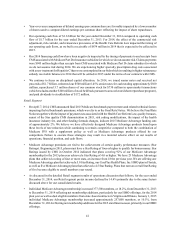Humana 2014 Annual Report Download - page 39
Download and view the complete annual report
Please find page 39 of the 2014 Humana annual report below. You can navigate through the pages in the report by either clicking on the pages listed below, or by using the keyword search tool below to find specific information within the annual report.31
statutory income and statutory capital and surplus. In most states, prior notification is provided before paying a dividend
even if approval is not required. Actual dividends paid may vary due to consideration of excess statutory capital and
surplus and expected future surplus requirements related to, for example, premium volume and product mix. Dividends
from our non-insurance companies such as in our Healthcare Services segment are generally not restricted by
Departments of Insurance. In the event that we are unable to provide sufficient capital to fund the obligations of Humana
Inc., our results of operations, financial position, and cash flows may be materially adversely affected.
Downgrades in our debt ratings, should they occur, may adversely affect our business, results of operations,
and financial condition.
Claims paying ability, financial strength, and debt ratings by recognized rating organizations are an increasingly
important factor in establishing the competitive position of insurance companies. Ratings information is broadly
disseminated and generally used throughout the industry. We believe our claims paying ability and financial strength
ratings are an important factor in marketing our products to certain of our customers. In addition, our debt ratings impact
both the cost and availability of future borrowings. Each of the rating agencies reviews its ratings periodically and there
can be no assurance that current ratings will be maintained in the future. Our ratings reflect each rating agency’s opinion
of our financial strength, operating performance, and ability to meet our debt obligations or obligations to policyholders,
but are not evaluations directed toward the protection of investors in our common stock and should not be relied upon
as such.
Historically, rating agencies take action to lower ratings due to, among other things, perceived concerns about
liquidity or solvency, the competitive environment in the insurance industry, the inherent uncertainty in determining
reserves for future claims, the outcome of pending litigation and regulatory investigations, and possible changes in the
methodology or criteria applied by the rating agencies. In addition, rating agencies have come under regulatory and
public scrutiny over the ratings assigned to various fixed-income products. As a result, rating agencies may (i) become
more conservative in their methodology and criteria, (ii) increase the frequency or scope of their credit reviews, (iii)
request additional information from the companies that they rate, or (iv) adjust upward the capital and other requirements
employed in the rating agency models for maintenance of certain ratings levels.
We believe that some of our customers place importance on our credit ratings, and we may lose customers and
compete less successfully if our ratings were to be downgraded. In addition, our credit ratings affect our ability to obtain
investment capital on favorable terms. If our credit ratings were to be lowered, our cost of borrowing likely would
increase, our sales and earnings could decrease, and our results of operations, financial position, and cash flows may
be materially adversely affected.
The securities and credit markets may experience volatility and disruption, which may adversely affect our
business.
Volatility or disruption in the securities and credit markets could impact our investment portfolio. We evaluate our
investment securities for impairment on a quarterly basis. This review is subjective and requires a high degree of
judgment. For the purpose of determining gross realized gains and losses, the cost of investment securities sold is based
upon specific identification. For debt securities held, we recognize an impairment loss in income when the fair value
of the debt security is less than the carrying value and we have the intent to sell the debt security or it is more likely
than not that we will be required to sell the debt security before recovery of our amortized cost basis, or if a credit loss
has occurred. When we do not intend to sell a security in an unrealized loss position, potential other-than-temporary
impairments are considered using variety of factors, including the length of time and extent to which the fair value has
been less than cost; adverse conditions specifically related to the industry, geographic area or financial condition of the
issuer or underlying collateral of a security; payment structure of the security; changes in credit rating of the security
by the rating agencies; the volatility of the fair value changes; and changes in fair value of the security after the balance
sheet date. For debt securities, we take into account expectations of relevant market and economic data. We continuously
review our investment portfolios and there is a continuing risk that declines in fair value may occur and additional
material realized losses from sales or other-than-temporary impairments may be recorded in future periods.





